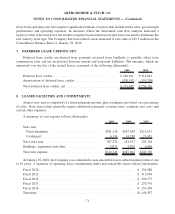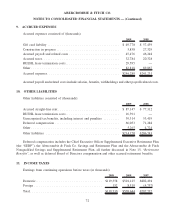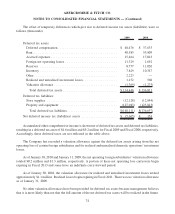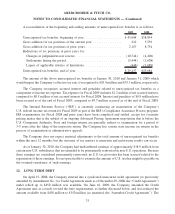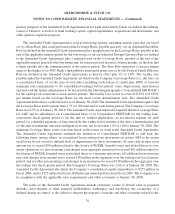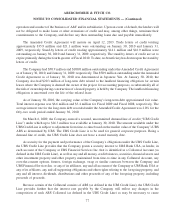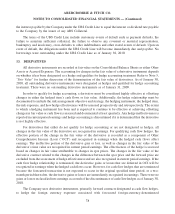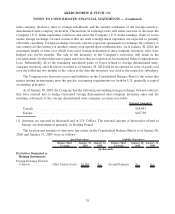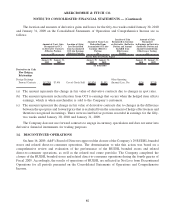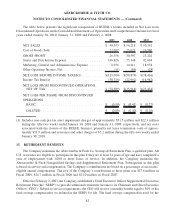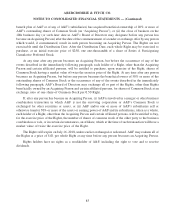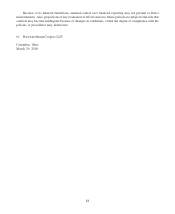Abercrombie & Fitch 2009 Annual Report Download - page 79
Download and view the complete annual report
Please find page 79 of the 2009 Abercrombie & Fitch annual report below. You can navigate through the pages in the report by either clicking on the pages listed below, or by using the keyword search tool below to find specific information within the annual report.the interest payable by the Company under the UBS Credit Line to equal the interest or dividend rate payable
to the Company by the issuer of any ARS Collateral.
The terms of the UBS Credit Line include customary events of default such as payment defaults, the
failure to maintain sufficient collateral, the failure to observe any covenant or material representation,
bankruptcy and insolvency, cross-defaults to other indebtedness and other stated events of default. Upon an
event of default, the obligations under the UBS Credit Line will become immediately due and payable. No
borrowings were outstanding under the UBS Credit Line as of January 30, 2010.
13. DERIVATIVES
All derivative instruments are recorded at fair value on the Consolidated Balance Sheets as either Other
Assets or Accrued Expenses. The accounting for changes in the fair value of a derivative instrument depends
on whether it has been designated as a hedge and qualifies for hedge accounting treatment. Refer to Note 5,
“Fair Value” for further discussion of the determination of the fair value of derivatives. As of January 30,
2010, all outstanding derivative instruments were designated as hedges and qualified for hedge accounting
treatment. There were no outstanding derivative instruments as of January 31, 2009.
In order to qualify for hedge accounting, a derivative must be considered highly effective at offsetting
changes in either the hedged item’s cash flows or fair value. Additionally, the hedge relationship must be
documented to include the risk management objective and strategy, the hedging instrument, the hedged item,
the risk exposure, and how hedge effectiveness will be assessed prospectively and retrospectively. The extent
to which a hedging instrument has been and is expected to continue to be effective at achieving offsetting
changes in fair value or cash flows is assessed and documented at least quarterly. Any hedge ineffectiveness is
reported in current period earnings and hedge accounting is discontinued if it is determined that the derivative
is not highly effective.
For derivatives that either do not qualify for hedge accounting or are not designated as hedges, all
changes in the fair value of the derivative are recognized in earnings. For qualifying cash flow hedges, the
effective portion of the change in the fair value of the derivative is recorded as a component of Other
Comprehensive Income (Loss) (“OCI”) and recognized in earnings when the hedged cash flows affect
earnings. The ineffective portion of the derivative gain or loss, as well as changes in the fair value of the
derivative’s time value are recognized in current period earnings. The effectiveness of the hedge is assessed
based on changes in fair value attributable to changes in spot prices. The changes in the fair value of the
derivative contract related to the changes in the difference between the spot price and the forward price are
excluded from the assessment of hedge effectiveness and are also recognized in current period earnings. If the
cash flow hedge relationship is terminated, the derivative gains or losses that are deferred in OCI will be
recognized in earnings when the hedged cash flows occur. However, for cash flow hedges that are terminated
because the forecasted transaction is not expected to occur in the original specified time period, or a two-
month period thereafter, the derivative gains or losses are immediately recognized in earnings. There were no
gains or losses reclassified into earnings as a result of the discontinuance of cash flow hedges as of January 30,
2010.
The Company uses derivative instruments, primarily forward contracts designated as cash flow hedges,
to hedge the foreign currency exposure associated with forecasted foreign-currency-denominated
78
ABERCROMBIE & FITCH CO.
NOTES TO CONSOLIDATED FINANCIAL STATEMENTS — (Continued)





